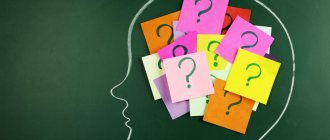Recommendations for the development of auditory memory in preschoolers
Pediatricians from all over the world recommend actively developing visual, motor, auditory, figurative and verbal memory from childhood. At the same time, do this at the same time, since all varieties are connected with each other and help in learning and personal growth. In order for a child to grow fully, parents should play with him and do various exercises. The program must take into account the characteristics of his age.
Auditory memory
It is important to achieve the child’s perseverance so that he can effectively remember different material. To achieve this, the following is recommended:
- Group material into classes with subgroups to reduce the load.
- Use associations so that you can easily learn the material and connect it with what you already know.
- Structure the material according to a logical and hierarchical principle so that it is perceived as a single whole.
- Add support points to the age program, that is, a certain plan. These can be dates with titles, names, unusual phrases and highlights.
- Connect schematic and graphic images so that visual memory develops simultaneously with auditory memory, and a logical chain of thoughts is established.
On a note! In addition, experts advise making the program varied and starting every day of class with interesting visual moments, including the child’s favorite cartoon characters, and doing a dictation with the placement of commas.
Peculiarities of memory of preschool children
Children of preschool age have involuntary memory and cannot yet remember something purposefully, by their own will or consciousness. Voluntary memory in preschoolers begins to form at the age of 7. For this reason, with a high probability, the child will be able to remember some bright and unusual moment, something that is not interesting to him.
It is important to note that during development, parents are faced with a lack of increased attention, the inability to teach their child to listen and stay still. Without concentration, it is difficult to achieve high-quality memorization of the first stories, poems, music and other things. To form voluntary memory, it is necessary that the baby is concentrated and knows how to listen.
Peculiarities
How to test a child's auditory memory
To test the auditory memory of a four- or five-year-old child, you don’t have to suffer for a long time and turn to specialists. Just run short tests. One of them is aimed at repeating words spoken in advance, and the other - numbers. When working with an older child, you can test his memory by letting him listen to a song or a story several times.
Luria's 10 words test
The Luria test is the best in psychology. Aimed at obtaining information about the level of development, the volume of memorization and fatigue. Also aimed at increasing attention. It can be used to test both preschoolers and adults.
Before conducting the test, you need to prepare 10 random words in advance. These can be phrases in the form of a chair, window, book, star, cat, plate, flowers, bedspread, plate and sun.
How to teach a 4-5 year old child to draw
On a note! These phrases must be read out within 20 seconds, pausing for 2 seconds. The child should listen to them carefully and try to remember the series.
After he listens to them, he needs to try to repeat all the words that he remembers. Then you need to repeat all the phrases 3 times, each time adding a new phrase, and each time record the words that the child was able to remember.
A preschooler with normal memory remembers 6 words after a set is read to him for the first time. The fourth time he says 8 words. For adults, the result is 7 words after the first reading and all words after the last. Later, this test can be improved by using more phrases or connecting pictures to them, turning the exercise into a kind of game.
Wechsler's Counting Test
The Wechsler test is similar to the Lurian test, but it uses numbers instead of words. The subject is asked to memorize 10 numbers, 3 numbers for the first stage. After repeating them, 3 more digits are added to the 3 numbers. The exercise is repeated until an error is made. In the second stage of the test, the test taker needs to remember the given numbers in reverse order. The normal indicator is 6 and 5 digits in the first and second stages, respectively.
Wechsler test
How to measure a child's memory
Development of memory in preschool children. You can measure your child's memory using special tests.
Visual memory
The child is invited to look at the pictures. It will take one and a half minutes to open. Then the child is asked to draw from memory what he saw.
If the child correctly drew most of the objects, his memory is good. If not, there are memory problems.
Another option is to show the child pictures, ten in total. Then they ask him to name the objects he saw.
If the child correctly named more than 8 pictures, his memory is good. If you made a mistake about five times, the result is average. If you made more than five mistakes, then your memory is bad.
Auditory memory
The teacher calls out the numbers, the child must repeat after him. If the child names at least 5 numbers from a series correctly, then his memory is good.
Recognition test
The child is shown a picture depicting certain objects. Then he is asked to find these objects in a large picture.
If a child managed to find at least eight out of 10 objects, his memory is good. Made more than five mistakes - the result was weak.
Exercises for concentrating and developing auditory memory
In order for a child to learn to concentrate his attention on sounds and develop auditory memory, he needs to perform the following exercises to develop auditory memory:
- "Snowball". It is better to do it in pairs or in a team. One child names a word, the neighbor repeats and names another one. This continues until a mistake is made.
- "Bug". A chessboard is set up and a beetle figurine is placed on it. An adult gives the child commands to move the beetle and the child remembers them. Then it plays.
- "What color". Take a coloring book with a prepared plot. The parent reads the story and invites the preschooler to color the figures in accordance with the indicated colors in the story.
- "Story". A game of continuation of phrases. It consists of the following: the adult begins the story, the child continues, and so on. At the end, the players try together to remember what happened in the story.
- "Associations". Different pictures are laid out in front of the subject. Different words are spoken, and he tries to combine what he heard with what he saw.
On a note! To improve memory in children, you can turn on audio cassettes with songs and let the child listen to them several times, and then ask them to repeat and write.
Short and simple poems will also help. Subsequently they can be difficult. They can turn out to be operational tools for learning and increasing the level of memorization.
Listening to sounds
Listening to sounds and remembering them is the best way to develop memory, starting at age 2. At the beginning, these can be sounds of nature, then - complex exercises, according to which the preschooler must repeat them in turn, randomly and in the opposite order. Subsequently, these can be complex names of classical melodies that are played in the theater.
Mathematics classes with children 3-4 years old at home and in kindergarten
Reading aloud
Reading aloud develops not only visual and abstract memory, but also auditory memory. It helps improve vocabulary and spelling. To develop concentration in this way, you can not just read fairy tales and stories, but also memorize individual phrases by trying to repeat them.
On a note! Interestingly, reading aloud in younger groups helps improve concentration. Therefore, meeting children of the same age is useful for thinking.
Learning poems
Poems are an excellent method for improving visual and auditory memory and imagination. At the beginning, with a 3-4 year old boy or girl, it is better to memorize short quatrains. Then move on to more serious classical works. It is important that the poems are accompanied by vivid material. Then, through abstraction and visual perception, the reader will be able to remember more and learn not only to mindlessly pronounce memorized Russian and English words, but also to try to understand their essence.
Second phase
After the diagnosis, the following work is carried out with children:
• results are processed and summed up; • a long-term thematic plan of work on this topic is drawn up; • individual plans include work aimed at memory correction; • subgroups of children are formed based on impaired function; • a list of games is compiled aimed at developing each of the functions (see appendix); • games aimed at developing auditory and visual memory, as an element or organizational element, are included in frontal classes. Work on this topic runs like a thin thread through all types of activities.
The work system is designed for joint activities of a child and an adult. First, the adult initiates the classes and forms a keen interest in the work. Special conditions must be created for adults:
1. Setting to remember. 2. Emotional involvement. 3. Motivation. 4. Active work with material that needs to be remembered.
The main goal is to help the child make the most of his memory.
For everything to work out, you need to remember a number of simple rules:
• Do not start classes in a bad mood. • Do not start classes if the child is not feeling well. • Do not start classes if the child is busy playing. Try warning him about the start of the lesson about five minutes in advance, offering to put away the toys and ending the game. The child should have time to transition from play to activity. • The activity should never be perceived by the child as a punishment.
While working on a task, your child may make mistakes. How should we treat them? Calmly. Mistakes are evidence that the child is doing something, mastering something, developing. And if everything doesn’t work out right away, then there are growing pains. Everything will definitely work out, you just need to believe in it yourself and instill this confidence in the child. If errors are repeated frequently, it is necessary to find out their cause.
Numerous errors may occur if:
• The child is tired; • The child is not interested because the tasks are either too simple or very difficult; • Errors may be associated with the characteristics of the child’s neuropsychic organization, the consequences of traumatic brain injuries, and infectious diseases.
Memory processes are greatly influenced by motivation. Therefore, it is important what motive is formed in the child. The most effective is the motive associated with the child’s inner desire to grow, develop, communicate, ask questions and look for answers, because it is very interesting and enjoyable. If a child is engaged in activities to please you (by the way, do not forget to praise him and support him), then gradually he will feel the taste of such activities and will strive for them, regardless of whether he is praised or not.
To increase interest in classes, there is a very effective technique when an adult cedes the role of teacher to the child. This is not only unusual, but also useful. By explaining the task to the “student”, the child himself begins to better understand the meaning of what he is doing. The function of control and self-control is formed.
All practical material presented consists of three blocks.
Methods for developing tactile memory
Tactile memory is a person’s ability to remember the sensations of touching a particular object. To develop tactile memory you will need the following exercises:
"Find by touch"
The child is asked to choose one from a variety of objects based on specific tactile characteristics. For example, a child is told that this object is soft and fluffy. Or rough, prickly.
"Game with mood"
The child has associations about objects. If an object is soft and pleasant to the touch, then this object is in a good mood. Which object is in a sad mood? Or evil? The child, relying on tactile sensations, selects objects.
"Tales with tactile details"
In this case, the child participates in a theatrical production, where the plot of a fairy tale is heard, and all the characters and objects surrounding them can be touched and determined what they are: soft, rough, hard, prickly, etc.
Games to develop fine motor skills in children
Development of arbitrary logical memory
The ability to classify leads to the development of arbitrary logical memory, so it is important to give children exercises where they must use methods of classification, analysis, comparison and generalization.
Didactic game "Cards"
Children are asked to select images based on specific characteristics and arrange them in piles. For example, from pictures with birds and animals, you need to put pictures with birds in one group, and pictures with animals in another. Themes for the game can be different: sports, furniture, seasons, plants, etc.
"Twins"
Among different pictures, the child must find two identical ones.
Educational games for children
“The sea is agitated once.” Together with your child, come up with poses for the letters T, O, K, F, L, X. Then turn on the music and invite your child to dance. As soon as the melody ends, say one of the letters. The child must immediately take the agreed position.
"What's there?" Invite your child to listen and remember what is happening “on TV.” Ask him to tell him what he heard
At a signal, the child’s attention switches from the TV to you and vice versa. Then the baby must tell what happened and where
"Chain of Actions". Offer your child a sequence of actions to perform step by step. For example, give the instruction: “Go to the kitchen. Take a bouquet of flowers and bring it to the hall. Put them in a vase."
“Remember and repeat.” Give your child a few numbers and ask them to repeat. In this case, the number of numbers must be increased. The sum of words is from one to ten. Name the numbers in random order, ask them to repeat “back to front,” that is, in reverse order. Name the words in random order, and then ask them to repeat it in reverse.
"Vocabulary seven". Read 7 words: cat, house, tram, plane, girl, mother, vacuum cleaner. Ask your child to remember and repeat these seven words. If he is having a hard time, give your child a piece of paper and colored markers. Offer to make a drawing for each of the named words, which would help later remember these words.
"Seven phrases" Name seven phrasal phrases.
- The bear is frozen.
- The little hare is running.
- The wolf is angry.
- Granny is sleeping.
- Grandfather is fishing.
- Mom is reading.
- Children are walking.
Ask your child to listen, remember and repeat these phrases. If your child finds it difficult to complete this task, ask them to draw a diagram for each of the phrases. Let him then accurately reproduce all the phrases. If difficulties arise, help with hints. Notice how the drawings help him. A good survey result is 6-7 phrases.
Editorial: Headache during pregnancy
"Fantasy". Take pictures that depict certain events. Let the child come up with three sentences based on these drawings. Then he will need to repeat them.
"Text analysis". Read a text taken from a story or any other literary work. Then ask him to retell what he heard. If the child finds it difficult, re-read the passage to him again (with more expression). Ask what the fairy tale (story) is about. Try to draw a parallel with what is familiar and well known to the baby and compare with the new things that he learned from what he heard. Ask for parallels between similarities and differences. When answering questions, the baby thinks, compares, shares observations, thinks. Such a dialogue can well develop a child’s auditory memory and thinking. Let him retell the text. In turn, you will see how much more meaningful his retelling has become.










